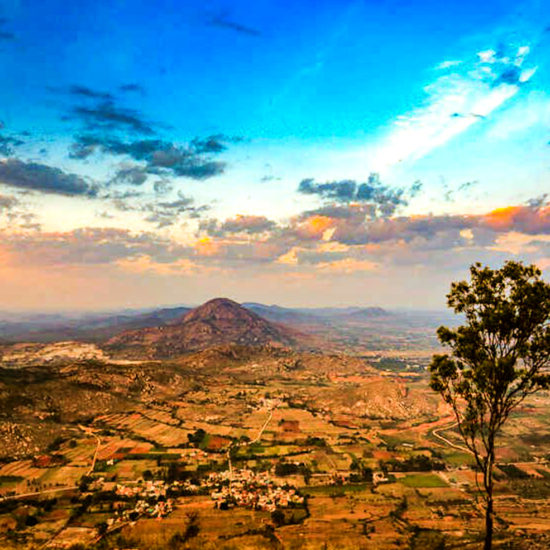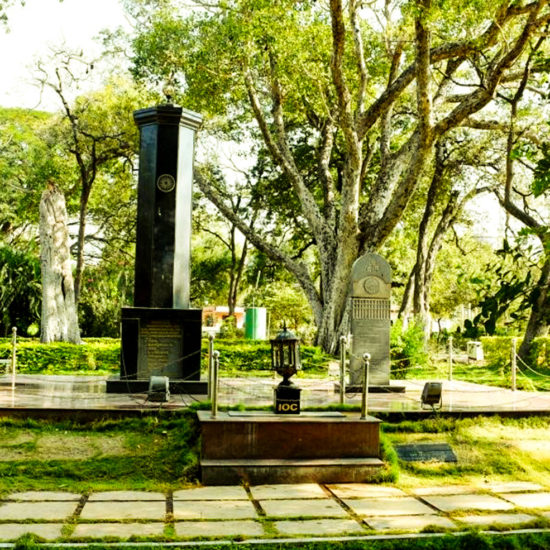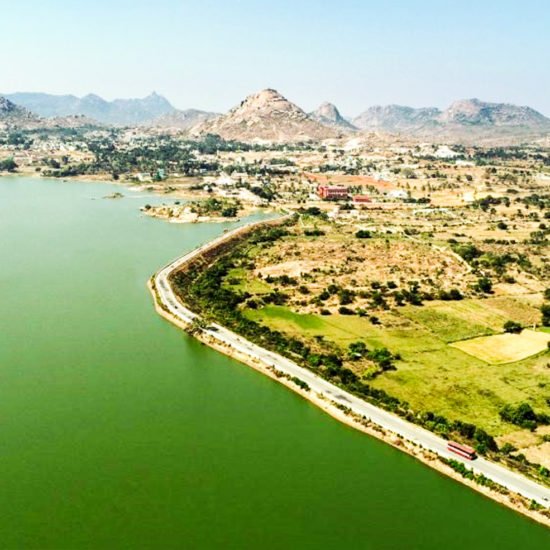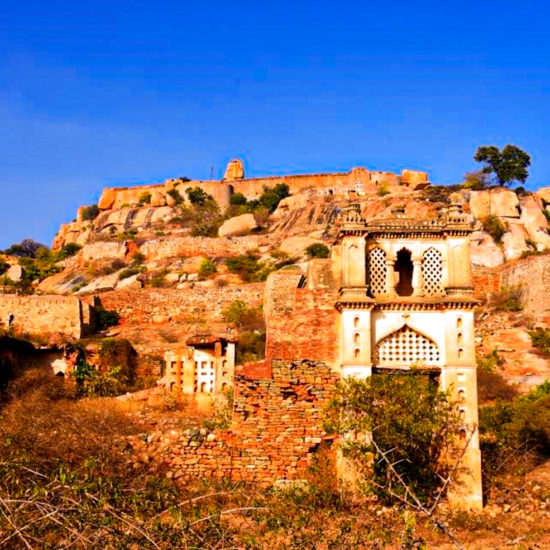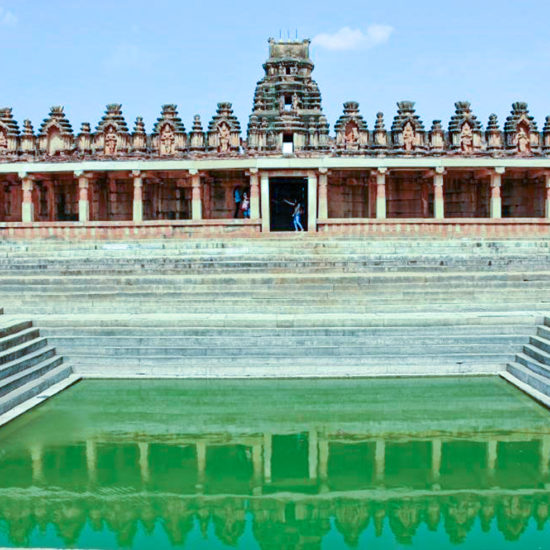Chikkaballapur district is a newly created district in the state of Karnataka. Chikkaballapur was formed in 2007 when it was carved out of the existing Kolar district. The district is surrounded by Kolar in the southwest, Bengaluru Rural in the south, Tumkuru in the west and Andhra Pradesh state in the north. Chikkaballapur is located around 60 km from Bengaluru city and due to this proximity, attractions in Chikkaballapur is a favourite weekend getaway for the Bengaluru crowd.
Nandi Hills is undoubtedly the most famous attraction here. Skandagiri Hills, Temples of Bhoganandishwara and Yoganandiswara are the other prominent attractions here. The most famous personality from Chikkaballapur was India’s most respected engineer and former diwan of Mysuru, Bharat Ratna Sir M Vishveshvaraya who was born in Muddenahalli village. His birthplace is now a memorial and museum.
According to legends, Chikkaballapur was founded in 1479 by Malla Baire Gowda, the youngest son of Baire Gowda of Avati. The village which originally occupied the site was called Kodimanchanahalli. Today it is a commercial centre is well known for its manufacture of Candy sugar (crystal sugar) and for its silk industry. A lot of tourist spots also await tourist here like Nandi Hills, Skandagiri Hills, Bhoganandishwara and Yoganandishwara temples etc.
The 6th edition of the Bird Fest was organized on January 17th, 2020 by the Karnataka Eco-Tourism Board and the mascot for the festival this year was the ‘Vulture’. Stay tuned to all updates about all Bird Festivals and other updates from https://myecotrip.com/ handled by the Karnataka Forest Department.
For further information, visit the official district website click here!
Tourist Attractions
- Nandi Hills: Nandi Hills also called Nandi Durga is arguably the most popular weekend destination for the city crowd of Bengaluru. The rivers North Palar, South Pennar, Chitravathi, Arkavathi and Papaghni take their birth at Nandi Hills. It has been under the control of Paleyagars of Chikkaballapura, Tipu Sultan, Marathas and finally the British. It was called 'Nandigiri' in the ancient inscriptions. The bracing air and serene environs of Nandi Hills, perched at an altitude of 4850 feet above sea level, provided the British and Tipu Sultan with an idyllic summer retreat. The weather at Nandi hills is pleasant throughout the year and here, you can take leisurely strolls. Adventure sports lovers can try their hand at parasailing. An ideal trekking destination, the prominent places which can be visited from Nandi hills are to the north west-Channakeshava Betta (4762 ft), south west Brahmagiri (4657 ft), north, Skandagiri (4749 ft) south the steep precipice and the well at the bottom called "Shravana Tirtha."Two ancient temples dedicated to Lord Shiva are located in Nandi Hills. The Yoganandishwara Temple on top of the Nandi Hills has the architecture of the Chola style and located in a village Nandi Grama near to Nandi Hills is the Bhoganandishwara Temple.
- Papagni Matha: One of the ancient and oldest Matha of Karnataka is Papagni Matha and is located at Skandagiri Hills. Special poojas are performed every Saturday.
- Gudibande: As the town lies in the south of a huge rocky hill with a temple is said to have got the name Gudibande. Gudibande is a 17th century fort built by local ruler Havali Byregowda. The Palegar's fort and its encampments on the hill top of Gudibande are now in ruins. There is the Rameshwara temple on the top of the hill. In the fort area, even today we can find many rocky passages, steps created on the rocks, water springs, storehouses for arms & ammunitions and storage cells for food grains. The big grinding stone used for preparation of gun powder can be seen even now. Gudibande offers Easy to moderate hiking opportunity. Beautiful views of the city and Byrasagara Lake below, along with cool breezes make Gudibande a sought after destination.
- Byrasagara Tank: A giant lake at the bottom of Gudibande.
- Muddenahalli: Muddenahalli, situated 3 km away from Chikkaballapura is a small village, but has become famous as being the birth place of Bharat Ratna Sir M. Visveswariah, acclaimed as the architect of modem Karnataka. Visit the home of Bharat Ratna Sir M. Visveswariah, who was a Diwan in the erstwhile Mysore State, which has been converted as a museum at Muddenahalli.
- Museum: Sir M Vishveshwaraya memorial in Muddenahalli showcases several personal belongings of the great engineer. Vision, simplicity, knowledge and clarity of thought Sir M Vishveshwaraya had is truly inspiring, particularly if one is from the engineering fraternity.
- Srinivasa Sagara: A beautiful lake near Chikkaballapur.
- Jakkalamadagu dam: A reservoir providing drinking water to Chikkaballapur.
- Gummanayaka Fort: This fort is situated 16 km east of Bagepalli, was founded around 1350 by a feudatory chieftain Gummanayaka and ruled for several years by him and his successors. Gummanayaka Fort which is within easy reach from Bagepalli has been a place of pilgrimage is remarkable for its greenery and scenic beauty. The fort walls are about 50 ft. high from the ground level.
- Chennakeshava Betta: 8 kms southwest of Chikkaballapur, Chennakeshava betta has a large cave temple and invites trekkers and adventure seekers. Rivers Uttara Pinakini and Dakshina Pinakini originate in Chennakeshava Betta.
- Rahmangad: Home to old forts and temples, 11 kms southwest of Chintamani.
Adventure/Activities
- Skandagiri Trekking: Skandagiri, also known as Kalavara Durga, is an ancient mountain fortress at an altitude of 4749 ft and overlooks Nandi Hills and Muddenahalli. It is probably one of the popular weekend getaways from Bengaluru in Chikkaballapur apart from Nandi Hills. It is also famous as a night trek destination. Skandagiri hiking is a day long trip that is usually commenced after breakfast in the morning. The total hiking distance is about 8 kms wherein the difficulty level is moderate to tough. Hiking to Skandagiri commences from the Papagni Temple, which is located at the foothills of the Kalwara village. There is also an old abandoned Shiva temple at the peak where the hikers can relax and enjoy the view of the magnificent surroundings.You may book your treks from https://myecotrip.com/ which is run and handled by Karnataka Forest Department.
Religious Places
- Boganandishwara Temple: Probably the most popular temple in Chikkaballapur. Dravidan style Boganandishwara Temple in Nandi village was constructed at around 806 A.D. by Rathnavalli of Bana Dynasty. Boganandishwara Temple is known for its captivating architecture, large tank surrounded by long square shaped corridors and intricate carvings.
- Ranganathaswami Temple, Rangasthala: On the Chikkaballapura-Gauribidnur highway about 2 km from Thippenahalli is Rangasthala which is famous for its Sri Ranganathaswami Temple built during Hoysala period. From the point of view of architecture, this temple of Ranganatha belongs to the pre-vijayanagara or Hoysala period. The main entrance of the temple is facing South, having navaranga and an elegant mukamantapa. The mukhamantapa is built on a raised platform having 24 stone pillars. The 14 stone pillars having Vaishnava relief which seem to be a part of the mukhamantapa also have very fine relief figures of the Vaishnava Puranas. The Sheshashyana Ranganatha idol inside the garbhagriha is four feet tall and attractive. On top of the garbhagriha a square shaped shikara is built in Dravidian style. During the 12th century A.D, the eminent Vaishnava Guru Parashara Bhatta has composed "Sri Rangaraja Stotra" a work of hymns on the deity Sri Ranganatha in Sanskrit in Rangasthala.
- Arunachaleswara temple: Another temple built in soap stone, very close to Boganandishwara Temple, where fine Ganga, Chola and Hoysala style architecture can be seen
- Kaiwara: This historical town is associated with the epic, Mahabharatha and was known as Ekchakrapura. Kaivara is believed to be the place where the Pandavas lived in exile for some time after they escaped from araginamane (house of wax). As per legends, it is also told that Bhima killed the demon Bakasura who lived in these areas and hid the dead body in a cave nearby. It is told that during rainy season, reddish or white earthen fluid oozes out from the crevices of the hill. The local people believe this to be the blood and pus from Bakasura’s dead body hidden in the cave. Moreover, Kaivara is home to temples of Amaranareyana, Dharamaraya, Bhimeshwara, Arjuneshwara, Nakuleshwara and Sahadeveshwara.
- Murugamalla, Chintamani: Murugamalla, is 11 km away from Chintamani, and a fort is situated on a hill of about 600 feet high, also known as Murugamalla. It is believed that the fort was built in 18th century but now in ruins. At the foot hills is an ancient Shiva temple, built during Paleyagar period. It is also home to one of the oldest dargahs in Karnataka, the Dargah of Peer Fakir Shah Wali. An Urus of the Peer is held annually and devotees from not only Karnataka but also from adjacent states participate in it. The devotees believe that the Peer has the power to cure certain diseases.
- Vidhuraswatha: Vidurashwatha, situated at 6 km from Gauribidanur taluk is an important pilgrim centre and is situated on the banks of Pinakini River. Vidurashwatha gets its name from Vidura (brother of Pandu and Dhiritarashtra of the epic Mahabharatha). It is also believed to be the abode of Sage Maithreya. According to legends, Vidura came here and stayed at Sage Maithreya's hermitage. During his stay, Vidura nursed a Peepal sapling planted by the hermit. Over time, a temple of Lord Aswathanarayana came up here and the large Peepal tree that we see today is the same tree which makes it hundreds of years old. Under this tree, are consecrated large number of snake stones which are objects of worship. This is a place where Naga Pratishta (snake worship) is practiced and many childless couples visit this temple and pray for offspring and take a vow to install a snake stone in return. A car festival and a fair in the month of April is the annual celebrations of Vidurashwatha. There are shrines here dedicated to Lord Shiva, Lord Narayana, Lord Rama and the navagrahas.Apart from being a pilgrim centre, Vidurashwatha has played a distinctive role in the Indian freedom struggle. In 1938, thousands of people arrived at Vidurashwatha to take part in a Satyagraha and tried to hoist the Congress flag. The police opened fire and many unarmed protesters lost their lives. This gained lot of media attention in those days and due to its similarity to the Jallianwala Bagh massacre led this incident to be called as the "Jallianwala of Mysore". A cenotaph stands tall here in memory of the martyrs. Veerasoudha, the House of the Martyrs houses a picture gallery and a library. The complex also has an open-air theatre, auditorium and a play site for children.
- Minakanagurki: Minakanagurki, is located in Gauribidnur taluk. It is popularly called as "Maheshwari kshetra." There are Sri Maheshwari Temple and Kondaraya Mutt at this place. There are other temples here including temples dedicated to Chowdeshwari Gangamma, Bhadrakalamma, Plegamma, Doddamma, Eluvaladamma (the Saptamatrikas), Sri Rama, Muneshwara, Kumbheshwari, Hanumantha, etc.
- Venkataramana Temple, Alambagiri: Alambagiri is situated 10 km away from Chintamani and has been a famous religious centre because of its Thirumalanatha or Venkataramana Temple. The temple has inner garbhagriha, two ardhamantapas, a large Navaranga and a rectangular Mukha mantapa. According to local belief, the idol of Lord Venkatesha is believed to be a Swayambhu (self-manifested). The deity is worshiped as per the Vaikhanasa Agama rituals and the annual Bramha Rathotsava (car festival) is being celebrated with great religious fervour. There is a tall Dhwajastambha (Flag Pillar) in front of the temple. Nearby are the temples of dedicated to Lord Anjaneya (Hanuman) and Kshetrapala (guardian deity of the place).
- Kailasa Kshetra: A religious centre with multiple cave temples, 5 kms from Chintamani town. Ranganathaswamy and Chennakeshava cave temples at Vaddahalli near Kailasa Kshetra have naturally formed snake hood formations on the rocks.
- Mahakailasagiri: Situated at a distance of 6 km from Chintamani, Mahakailasagiri of Ambajidurga is famous for its rock-cut cave temples carved out with the help of modern technology. Kailasagiri can be reached by travelling through Bangalore-Chintamani road and turning right towards Ambajidurga. The natural hills of these ranges look like three precipices reaching high and appear like the figures of Lord Ganesha, Lord Gangadhara and Lord Maheshwara from a short distance to the devout eyes of pilgrims.
Tour Location
Chikkaballapura is 60 kms north of Bengaluru and well connected by Air, rail and road network from all over Karnataka.

Premium:
KSTDC Mayura Pine Top
Nandi Hills, Chikkaballapur Manager: Mr. Manjegowda Contact Number: +918618799919 +918618799918 Email: [email protected]Aeon Root Bridges
Tranquil Stay
White Nirvana Villa




